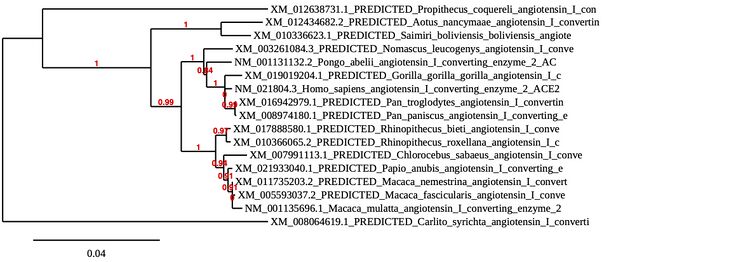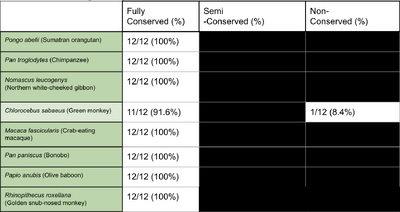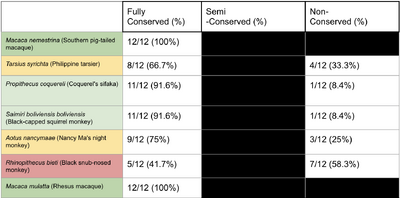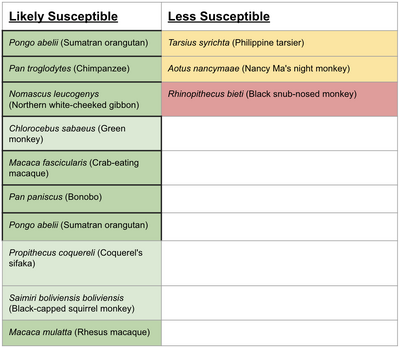Jennymchua Week 14 Assignment
Purpose
The purpose of our final research project is to compare angiotensin-converting enzyme 2 (ACE2) receptors across primates, including homo sapiens, in order to further investigate the structure-function relationship between ACE2 in humans and the SARS-CoV-2 spike protein. Our goal is to compare seventeen primate ACE2 amino acid sequences and determine if there are any "hot spots" in certain regions that could account for why some species, such as humans, are affected by the novel coronavirus and others are not.
Methods/Results
Collecting BLAST sequences
- Searched on UniProt "ACE2 family" to obtain names of primate species that had known or predicted ACE2 nucleotide sequences. Came up with seventeen results:
- Homo sapiens (Human)
- Chlorocebus sabaeus (Green monkey)
- Gorilla gorilla gorilla (Western lowland gorilla)
- Macaca fascicularis (Crab-eating macaque)
- Macaca mulatta (Rhesus macaque)
- Nomascus leucogenys (Northern white-cheeked gibbon)
- Pan troglodytes (Chimpanzee)
- Pan paniscus (Bonobo)
- Papio anubis (Olive baboon)
- Aotus nancymaae (Nancy Ma's night monkey)
- Carlito syrichta (Philippine tarsier)
- Macaca nemestrina (Southern pig-tailed macaque)
- Pongo abelii (Sumatran orangutan)
- Rhinopithecus bieti (Black snub-nosed monkey)
- Rhinopithecus roxellana (Golden snub-nosed monkey)
- Saimiri boliviensis boliviensis (Black-capped squirrel monkey)
- Propithecus coquereli (Coquerel's sifaka)
- Entered "*species name* ACE2" into NCBI Nucleotide search and downloaded sequences in FASTA format.
Phylogeny.fr
- Pasted all seventeen ACE2 nucleotide sequences into Phylogeny.fr and generated a phylogenetic tree.

Analysis of conserved sequences
- Clustally aligned human and primate ACE2 sequences and analyzed in Microsoft Excel.
- Determined sequences had 94.25% consensus.
- Residues with different polarities were deemed "non-conservative".
- Residues with same polarities but different identities were semi-conserved.
Finding relevant residues
- Retrieved FASTA protein sequences from Pan troglodytes, Pan paniscus, Homo sapiens, and Pongo abelii.
- Aligned sequences together to see if they have residue differences in the areas highlighted by Yan et al. (2020) due to their close relativities to each other.



CLUSTAL FORMAT: MUSCLE (3.8) multiple sequence alignment
ACE2_Sumat MSGSSWLLLSLVAVTAAQSTIEEQAKTFLDKFNHEAEDLFYQSSLASWNYNTNITEENVQ
ACE2_Human MSSSSWLLLSLVAVTAAQSTIEEQAKTFLDKFNHEAEDLFYQSSLASWNYNTNITEENVQ
ACE2_Chimp MSGSSWLLLSLVAVTAAQSTIEEQAKTFLDKFNHEAEDLFYQSSLASWNYNTNITEENVQ
ACE2_Bonob MSGSSWLLLSLVAVTAAQSTIEEQAKTFLDKFNHEAEDLFYQSSLASWNYNTNITEENVQ
**.*********************************************************
ACE2_Sumat NMNNAGDKWSAFLKEQSTLAQMYPLQEIQNLTVKLQLQALQQNGSSVLSEDKSKRLNTIL
ACE2_Human NMNNAGDKWSAFLKEQSTLAQMYPLQEIQNLTVKLQLQALQQNGSSVLSEDKSKRLNTIL
ACE2_Chimp NMNNAGDKWSAFLKEQSTLAQMYPLQEIQNLTVKLQLQALQQNGSSVLSEDKSKRLNTIL
ACE2_Bonob NMNNAGDKWSAFLKEQSTLAQMYPLQEIQNLTVKLQLQALQQNGSSVLSEDKSKRLNTIL
************************************************************
ACE2_Sumat NTMSTIYSTGKVCNPNNPQECLLLEPGLNEIMANSLDYNERLWAWESWRSEVGKQLRPLY
ACE2_Human NTMSTIYSTGKVCNPDNPQECLLLEPGLNEIMANSLDYNERLWAWESWRSEVGKQLRPLY
ACE2_Chimp NTMSAIYSTGKVCNPNNPQECLLLEPGLNEIMANSLDYNERLWAWESWRSEVGKQLRPLY
ACE2_Bonob NTMSAIYSTGKVCNPNNPQECLLLEPGLNEIMANSLDYNERLWAWESWRSEVGKQLRPLY
****:**********:********************************************
ACE2_Sumat EEYVVLKNEMARANHYEDYGDYWRGDYEVNGVDSYDYSRGQLIEDVEHTFEEIKPLYEHL
ACE2_Human EEYVVLKNEMARANHYEDYGDYWRGDYEVNGVDGYDYSRGQLIEDVEHTFEEIKPLYEHL
ACE2_Chimp EEYVVLKNEMARANHYEDYGDYWRGDYEVNGVDGYDYSRGQLIEDVEHTFEEIKPLYEHL
ACE2_Bonob EEYVVLKNEMARANHYEDYGDYWRGNYEVNGVDGYDYSRGQLIEDVEHTFEEIKPLYEHL
*************************:*******.**************************
ACE2_Sumat HAYVRAKLINAYPSYISPIGCLPAHLLGDMWGRFWTNLYSLTVPFGQKPNIDVTDAMVDQ
ACE2_Human HAYVRAKLMNAYPSYISPIGCLPAHLLGDMWGRFWTNLYSLTVPFGQKPNIDVTDAMVDQ
ACE2_Chimp HAYVRAKLMNAYPSYISPIGCLPAHLLGDMWGRFWTNLYSLTVPFGQKPNIDVTDAMVDQ
ACE2_Bonob HAYVRAKLMNAYPSYISPIGCLPAHLLGDMWGRFWTNLYSLTVPFGQKPNIDVTDAMVDQ
********:***************************************************
ACE2_Sumat AWDAQRIFKEAEKFFVSVGLPNMTQRFWENSMLTDPGNVQKVVCHPTAWDLGKGDFRILM
ACE2_Human AWDAQRIFKEAEKFFVSVGLPNMTQGFWENSMLTDPGNVQKAVCHPTAWDLGKGDFRILM
ACE2_Chimp AWDAQRIFKEAEKFFVSVGLPNMTQGFWENSMLTDPGNVQKAVCHPTAWDLGKGDFRILM
ACE2_Bonob AWDAQRIFKEAEKFFVSVGLPNMTQGFWENSMLTDPGNVQKAVCHPTAWDLGKGDFRILM
************************* ***************.******************
ACE2_Sumat CTKVTMDDFLTAHHEMGHIQYDMAYAAQPFLLRNGANEGFHEAVGEIMSLSAATPKHLKS
ACE2_Human CTKVTMDDFLTAHHEMGHIQYDMAYAAQPFLLRNGANEGFHEAVGEIMSLSAATPKHLKS
ACE2_Chimp CTKVTMDDFLTAHHEMGHIQYDMAYAAQPFLLRNGANEGFHEAVGEIMSLSAATPKHLKS
ACE2_Bonob CTKVTMDDFLTAHHEMGHIQYDMAYAAQPFLLRNGANEGFHEAVGEIMSLSAATPKHLKS
************************************************************
ACE2_Sumat IGLLSPDFQEDNETEINFLLKQALTIVGTLPFTYMLEKWRWMVFKGEIPKDQWMKKWWEM
ACE2_Human IGLLSPDFQEDNETEINFLLKQALTIVGTLPFTYMLEKWRWMVFKGEIPKDQWMKKWWEM
ACE2_Chimp IGLLSPDFQEDNETEINFLLKQALTIVGTLPFTYMLEKWRWMVFKGEIPEDQWMKKWWEM
ACE2_Bonob IGLLSPDFQEDNETEINFLLKQALTIVGTLPFTYMLEKWRWMVFKGEIPKDQWMKKWWEM
*************************************************:**********
ACE2_Sumat KREIVGVVEPVPHDETYCDPASLFHVSNDYSFIRYYTRTLYQFQFQEALCQAAKHEGPLH
ACE2_Human KREIVGVVEPVPHDETYCDPASLFHVSNDYSFIRYYTRTLYQFQFQEALCQAAKHEGPLH
ACE2_Chimp KREIVGVVEPVPHDETYCDPASLFHVSNDYSFIRYYTRTLYQFQFQEALCQAAKHEGPLH
ACE2_Bonob KREIVGVVEPVPHDETYCDPASLFHVSNDYSFIRYYTRTLYQFQFQEALCQAAKHEGPLH
************************************************************
ACE2_Sumat KCDISNSTEAGQKLLNMLRLGKSEPWTLALENVVGAKNMNVRPLLDYFEPLFTWLKDQNK
ACE2_Human KCDISNSTEAGQKLFNMLRLGKSEPWTLALENVVGAKNMNVRPLLNYFEPLFTWLKDQNK
ACE2_Chimp KCDISNSTEAGQKLFNMLRLGKSEPWTLALENVVGAKNMNVRPLLNYFEPLFTWLKDQNK
ACE2_Bonob KCDISNSTEAGQKLFNMLRLGKSEPWTLALENVVGAKNMNVRPLLNYFEPLFTWLKDQNK
**************:******************************:**************
ACE2_Sumat NSFVGWSTDWSPYADQSIKVRISLKSALGNKAYEWNDNEIYLFRSSVAYAMRKYFLEVKN
ACE2_Human NSFVGWSTDWSPYADQSIKVRISLKSALGDKAYEWNDNEMYLFRSSVAYAMRQYFLKVKN
ACE2_Chimp NSFVGWSTDWSPYADQSIKVRISLKSALGDKAYEWNDNEMYLFRSSVAYAMRQYFLKVKN
ACE2_Bonob NSFVGWSTDWSPYADQSIKVRISLKSALGDKAYEWNDNEMYLFRSSVAYAMRQYFLKVKN
*****************************:*********:************:***:***
ACE2_Sumat QMILFGEEDVRVANLKPRISFNFFVTAPKNVSDIIPRTEVEKAIRMSRSRINDAFRLNDN
ACE2_Human QMILFGEEDVRVANLKPRISFNFFVTAPKNVSDIIPRTEVEKAIRMSRSRINDAFRLNDN
ACE2_Chimp QMILFGEEDVRVANLKPRISFNFFVTAPKNVSDIIPRTEVEKAIRKSRSRINDAFRLNDN
ACE2_Bonob QMILFGEEDVRVANLKPRISFNFFVTAPKNVSDIIPRTEVEKAIRKSRSRINDAFRLNDN
********************************************* **************
ACE2_Sumat SLEFLGIQPTLGPPNQPPVSIWLIVFGVVMGVIVVGIVVLIFTGIRDRKKKNKARNEENP
ACE2_Human SLEFLGIQPTLGPPNQPPVSIWLIVFGVVMGVIVVGIVILIFTGIRDRKKKNKARSGENP
ACE2_Chimp SLEFLGIQPTLGPPNQPPVSIWLIVFGVVMGVIVVGIVILIFTGIRDRKKKNKARSEENP
ACE2_Bonob SLEFLGIQPTLGPPNQPPVSIWLIVFGVVMGVIVVGIVILIFTGIRDRKKKNKARSEENP
**************************************:****************. ***
ACE2_Sumat YASIDISKGENNPGFQNTDDVQTSF
ACE2_Human YASIDISKGENNPGFQNTDDVQTSF
ACE2_Chimp YASVDTSKGENNPGFQNTDDVQTSF
ACE2_Bonob YASVDTSKGENNPGFQNTDDVQTSF
***:* *******************
- Used highlighted sequences in Yan et al. (2020) to determine if all sequences were the same by highlighting residues in yellow.
- Determined all species had the same residues in the same locations highlighted by Yan et al. (2020).
- Aligned other primate ACE2 sequences to human ACE2 to see if any of the primates had unique changes at relevant positions.
Predicting secondary structures
- Aligned Phylogeny.fr Homo sapiens ACE2 sequence with primate ACE2 sequences
- Analyzed clustal alignment results in Microsoft Word to look for identity differences in Y41, Q42, K353, and R357.
- Visualized SARS-CoV-2 and hACE2 from Yan et al. (2020) in UCSF's Chimera and changed residue identities to see how structure changed.
Results
- His in Y41H alteration in S. and A. is likely not positioned to interact with N501 in SARS-CoV-2 (Yan et. al., 2020)
- Glu in Q42E alteration is not likely positioned to interact with Q498 (Yan et. al., 2020)
- Altered residues also have different chemical characteristics
- Y41H
- A42E

Data and files
All seventeen primate ACE2 nucleotide sequences Phylogenetic tree of primate ACE2 nucleotide sequences
Scientific conclusion
Through our research, we found that many primates are probably susceptible to the SARS-CoV-2 virus based on similarities in their ACE2 nucleotide sequences when compared to huamns, specifically their binding residues. This information is helpful, as it could launch further protection of vulnerable species, such as orangutans and chimpanzees, and possibly could be critical in further drug development and testing for humans.
Acknowledgments
- I worked with my homework partners Nathan and Carolyn throughout the week via Zoom and text to discuss our final project and check-in with our individual progress.
- We corresponded with Dr. Dahlquistto refine our final project question and go over methods to answering it.
- Except for what is noted above, this individual journal entry was completed by me and not copied from another source.
Jennymchua (talk) 23:08, 29 April 2020 (PDT)
References
- NCBI (2020). PubMed. Retrieved April 25, 2020, from https://www.ncbi.nlm.nih.gov/pubmed/9770526.
- OpenWetWare (2020). BIOL368/20:Week 14. Retrieved April 23, 2020 from https://openwetware.org/wiki/BIOL368/S20:Week_14.
- Phylogeny.fr. (2020) Phylogeny.fr:Home. Retrieved April 25, 2020, from http://www.phylogeny.fr/.
- UniProt (2020). UniProtKB results "ace2". Retrieved April 23, 2020 from https://www.uniprot.org/uniprot/?query=ace2&sort=score.
My user page
Template link
Class Assignments
- BIOL368/S20:Week 1
- BIOL368/S20:Week 2
- BIOL368/S20:Week 3
- BIOL368/S20:Week 4
- BIOL368/S20:Week 5
- BIOL368/S20:Week 6
- BIOL368/S20:Week 8
- BIOL368/S20:Week 9
- BIOL368/S20:Week 10
- BIOL368/S20:Week 11
- BIOL368/S20:Week 13
- BIOL368/S20:Week 14
Weekly Assignments
- jennymchua Week 2 Assignment
- jennymchua Week 3 Assignment
- jennymchua Week 4 Assignment
- jennymchua Week 5 Assignment
- jennymchua Week 6 Assignment
- jennymchua Week 7 Assignment
- jennymchua Week 8 Assignment
- jennymchua Week 10 Assignment
- jennymchua Week 11 Assignment
- jennymchua Week 13 Assignment
- jennymchua Week 14 Assignment
Class Journals
- BIOL368/S20:Class Journal Week 1
- BIOL368/S20:Class Journal Week 2
- BIOL368/S20:Class Journal Week 3
- BIOL368/S20:Class Journal Week 4
- BIOL368/S20:Class Journal Week 5
- BIOL368/S20:Class Journal Week 6
- BIOL368/S20:Class Journal Week 8
- BIOL368/S20:Class Journal Week 9
- BIOL368/S20:Class Journal Week 10
- BIOL368/S20:Class Journal Week 11
- BIOL368/S20:Class Journal Week 13
- BIOL368/S20:Class Journal Week 14